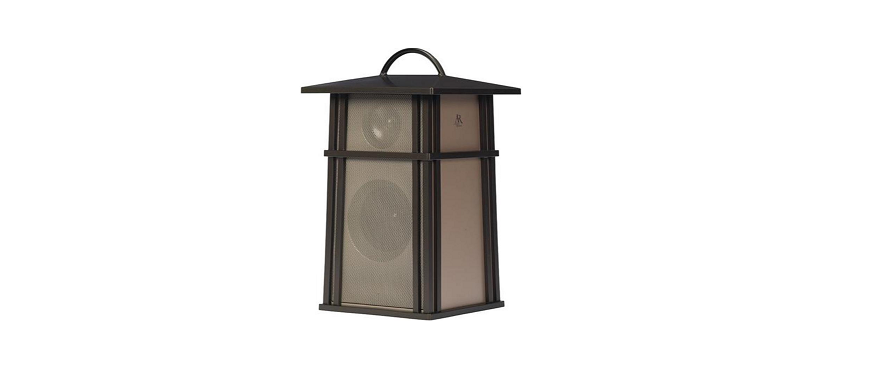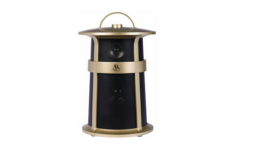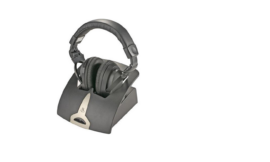Acoustics Research AWS5 Wireless Indoor-Outdoor Speaker
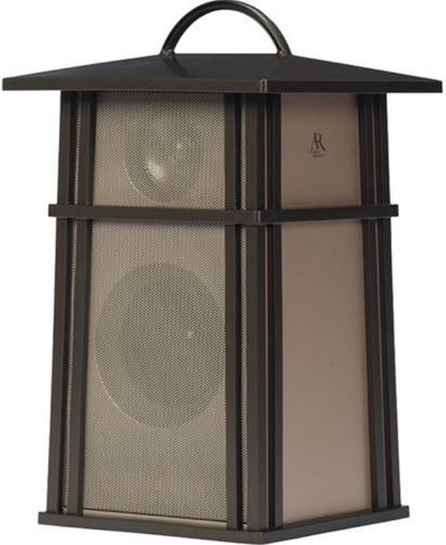
About Acoustics Research
AR’s Wireless Speaker System eliminates the hardest part of adding speakers to your home—running and hiding hundreds of feet of speaker wire. The AR Wireless Speaker System’s RF signal travels with ease through walls, floors, ceilings, and other obstacles, delivering high-quality sound virtually anywhere inside the house or out.
With drift- and static-free reception along with outstanding range—up to 150 feet*—the possibilities for enjoying your AR Wireless Speaker System are nearly unlimited.
The AR Wireless Speaker System is compatible with most audio sources, such as TVs, DVD players, VCRs, A/V receivers/amps, stereos, computers, and portable devices (CD players, cassette players, MP3s, etc.).
This manual covers various connection options and detailed operating instructions for making the AR Wireless Speaker System a valued part of your lifestyle. If, after having reviewed the instructions, you have any questions, please call toll-free 1-800-732-6866 or visit www.araccessories.com.
Important Information
Caution: To reduce the risk of electric shock, do not remove the cover (or back). No user-serviceable parts inside. Refer servicing to qualified service personnel.
Important Safety Instructions
- Read these instructions.
- Keep these instructions.
- Heed all warnings.
- Follow all instructions.
- Clean only with a dry cloth.
- Do not block any ventilation openings. Install by the manufacturer’s instructions.
- Do not install near any heat sources such as radiators, heat registers, stoves, or other apparatus (including amplifiers) that produce heat.
- Protect the power cord from being walked on or pinched particularly at plugs, convenience receptacles, and the point where they exit from the apparatus.
- Unplug this apparatus during lightning storms or when unused for long periods.
- Refer all servicing to qualified service personnel. Servicing is required when the apparatus has been damaged in any way, such as power-supply cord or plug is damaged, liquid has been spilled or objects have fallen into the apparatus, the apparatus has been exposed to rain or moisture, does not operate normally, or has been dropped.
Tour of the Speaker System
Speaker
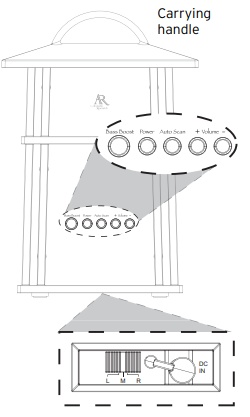
Front Panel
- POWER/LINKED indicator (not shown) blinks when the speaker is first powered on; it turns solid blue when the speaker is tuned to the transmitter
Rear Panel
- The Bass Boost button turns the speaker’s bass enhancement on and off
- The power button turns the speaker on and off
- Auto Scan button rescans for the transmitter’s signal
- Volume +/– buttons adjust the volume level
Bottom Panel
- L/M/R switch determines if the speaker plays sound in mono as a stand-alone speaker, or plays the left or right track in a stereo pair with an additional AWS5
- DC IN receives the small round end of one of the included 9V 1200mA AC power adapters; remove the protective cover to insert the adapter
- Battery Compartment Cover (not shown) removed to install 6 AA batteries
Transmitter
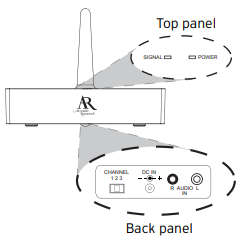
- SIGNAL indicator lights green when the audio is present and the transmitter is broadcasting
- POWER indicator lights when the transmitter is on CHANNEL 1 2 3 lets you fi nd the best transmission frequency for your environment
- DC IN jack receives the small round end of the included 12V 200mA AC power adapter
- AUDIO IN (R / L) connects to your sound source using one of the connection options shown here
Included Accessories

Note: These power units should be plugged in so that they stay vertical or lie fl at.
Connecting the Speaker System
Powering the Transmitter
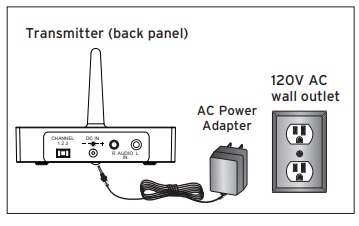
Connect the small, round plug from the transmitter AC power adapter to the transmitter’s DC IN jack. Plug the other end of the transmitter AC power adapter into any standard 120V AC wall outlet.
Note: Be sure to use the AC power adapter rated 12V DC 200 mA (it has the smaller diameter plug).
Connecting to an Audio Source
Connecting to an MP3 player, CD player, or computer

- Plug the stereo plugs on the provided Y-adapter audio cable into the AUDIO IN jacks on the back of the transmitter (make sure to match the colors on the plugs and jacks).
- Plug the mini-plug end of the provided Y-adapter into the headphone output of your MP3 player or CD player (or audio output jack on your computer).
Connecting to an A/V Receiver
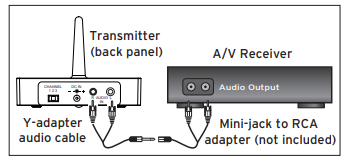
- Plug the stereo plugs on the provided Y-adapter audio cable into the AUDIO IN jacks on the back of the transmitter (make sure to match the colors on the plugs and jacks).
- Plug the mini-plug end of the provided Y-adapter into a mini-jack to RCA adapter (not included).
- Connect the stereo plugs on the mini-jack to RCA adapter to the corresponding left and right audio outputs of your A/V receiver, amp, or other audio source.
Powering the Speaker
There are two options to power your wireless speaker: using the included AC power adapter or using 6 AA batteries (not included).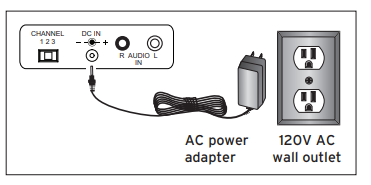
AC Power Adapters
- Insert the small, round plug from the speaker AC power adapter into the DC IN jack on the bottom of the speaker.
- Plug the other end of the speaker AC power adapter into any standard 120V AC wall outlet.
AA Batteries
- Remove the battery compartment cover on the bottom of the speaker.
- Insert six (6) AA batteries (not included) into the speaker following the polarity (”+” and “-”) as diagrammed inside the battery compartment.
- Replace the battery compartment cover on the bottom of the speaker.
Note: Place the rubber cap in the speaker power input jack when using batteries.
Pairing the Speaker System
Adjusting the Transmitter
- Turn on your audio source (for example, A/V receiver, MP3 player, stereo, etc.) and play music at a normal listening volume.
- Set the channel select switch on the back of the transmitter to one of the transmitter’s three broadcast frequencies: 1, 2, or 3. If you experience poor reception or interference, try choosing a different frequency by moving the channel select switch to another position.
Tuning the Speaker
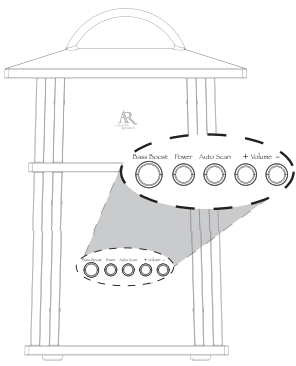
- Press the Power button on the back of the speaker to turn it on. The indicator light on the front of the speaker blinks while the speaker is tuning to the transmitter. The indicator light turns solid blue when the speaker is tuned to the transmitter—you should hear sound coming from the speaker now.
- Adjust the volume on the speaker as desired.
- Set up the speaker for mono or stereo operation using the switch on the bottom of the AWS5 speaker.
- Monaural operation: The monaural mode (mono) is recommended when using a single AWS5 by itself. For monaural operation, set the L/M/R switch to “M” on each speaker.
- Stereo operation: You need an additional AWS5 speaker for the stereo option. Set the L/M/R switch to “L” on the speaker located to the left of the listener, and set the other speaker to the “R” position.
More Helpful Information
About Fixed-Level Audio Outputs
A fixed-level, or line-level, audio output is considered ideal since it provides an audio signal unchanged by adjustments to the audio source volume control.
Hint: Fixed-level audio outputs from stereo receivers/amps will typically be designated as Tape (or Record) outputs or DVR/DVD-R audio output connections.
Troubleshooting
The following troubleshooting guide takes you through some of the more common problems associated with the installation and/or operation of a wireless system. If the problem persists, please call toll-free at 1-800-732-6866 or visit www.araccessories.com.
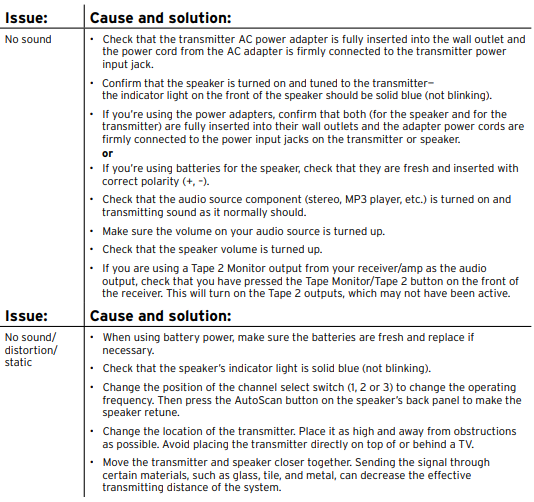
Specifications
Transmitter
- Omni-directional 900MHz broadcast
- Effective transmitting range: up to 150 ft. (45m)*
- Phase-locked loop circuitry (PLL)
- Automatic level control (ALC)
- 3 selectable broadcast frequencies
- Stereo audio input
Speaker
- Push-button, auto-lock tuning
- 2-way acoustic design: 2” tweeter, 3.5” woofer
- 5 Watt RMS internal amplifier
- Omni-directional sound
- Frequency response: 40Hz – 15kHz
- Left/Mono/Right switch
- Operates using supplied AC adapter or six (6) AA batteries (not included)
Care and Maintenance
- Always use a soft cloth to clean the speaker and transmitter. Never use any product containing alcohol or other solvents as they may damage the surface.
- Use caution when plugging the power transformers in an AC outlet to avoid the risk of electric shock.
- If the speakers are used outside on a deck or patio, make sure you take them indoors in the event of a rainstorm to prevent possible damage.
- Do not operate or store the system in extreme temperatures (below 32ºF/0ºC and above 122ºF/50ºC).
FCC Statement
This equipment has been tested and found to comply with the limits for a Class B digital device, under part 15 of the FCC Rules. These limits are designed to provide reasonable protection against harmful interference in a residential installation.
This equipment generates, uses, and can radiate radio frequency energy and, if not installed and used by the instructions, may cause harmful interference to radio communication.
However, there is no guarantee that interference will not occur in a particular installation. If this equipment does cause harmful interference to radio or television reception, which can be determined by turning the equipment off and on, the user is encouraged to try to correct the interference by one or more of the following measures:
- Reorient or relocate the receiving antenna.
- Increase the separation between the equipment and the receiver.
- Connect the equipment to an outlet on a circuit different from that to which the receiver is connected.
- Consult the dealer or an experienced radio/TV technician for help.
FCC Regulations state that unauthorized changes or modifications to this equipment may void the user’s authority to operate it.
Industry Canada Regulatory Information
This device complies with RSS-210 of the Industry Canada Rules. Operation is subject to the following two conditions: 1) this device may not cause interference and 2) this device must accept any interference, including interference that may cause undesired operation of the device.
This class B digital apparatus complies with Canadian ICES-003.
IC Radiation Exposure Statement: This equipment complies with IC radiation exposure limits set forth for an uncontrolled environment.
12-Month Limited Warranty
Audiovox Electronics Corporation (the “Company”) warrants to the original retail purchaser of this product that should this product or any part thereof, under normal use and conditions, be proven defective in material or workmanship within 12 months from the date of original purchase, such defect(s) will be repaired or replaced (at the Company’s option) without charge for parts and repair labor.
To obtain repair or replacement within the terms of this Warranty, the product along with any accessories included in the original packaging is to be delivered with proof of warranty coverage (e.g. dated bill of sale), specification of defect(s), transportation prepaid, to the Company at the address shown below. Do not return this product to the Retailer.
This Warranty is not transferable and does not cover products purchased, serviced, or used outside the United States or Canada.
The warranty does not extend to the elimination of externally generated static or noise, or costs incurred for the installation, removal, or reinstallation of the product.
Some states/provinces do not allow limitations on how long an implied warranty lasts or the exclusion or limitation of incidental or consequential damage so the above limitations or exclusions may not apply to you.
This Warranty gives you specific legal rights and you may also have other rights which vary from state/province to state/province.
U.S.A.:Audiovox Electronics Corp., 150 Marcus Blvd., Hauppauge, New York 11788
CANADA: Audiovox Return Center, c/o Genco, 6685 Kennedy Road, Unit #3 Door 16, Mississauga Ontario L5T 3A5
Trademark(s) ® Registered www.araccessories.com MADE IN CHINA AWS5 US IB 00
FAQs About Acoustics Research AWS5 Wireless Indoor-Outdoor Speaker
What is the range of wireless speakers?
Commercial electronics have a range of around 33 feet and are classified as class 2, which includes the majority of smartphones, headphones, earbuds, and portable speakers.
How do outdoor wireless speakers acquire electricity?
Yes, the majority of wireless speakers connect to a regular power strip or outlet using AC adapters. Certain systems employ rechargeable batteries to achieve “fully wireless” status; however, using this type of surround sound system necessitates routine tasks like charging and repositioning.
Is wireless speaker connectivity possible?
Yes, you may use a wireless audio transmitter and receiver kit to turn wired speakers into wireless ones.
Are batteries required for wireless speakers?
There are no wires with wireless speakers. This indicates that they are not connected to the electrical grid. If these speakers aren’t wired, they will require batteries because they require power from somewhere. Even if they are built in, these will still require frequent charging.
Do wireless speakers require a power source?
Indeed, power is required for wireless speakers to operate. They still require a power source to function even though they don’t need to be physically connected to a sound source. Rechargeable batteries, which may run wireless speakers for several hours on a single charge, power the majority of them.
Do latency-prone wireless speakers exist?
Even though it is very minor, the distance between speakers and your ears and the signals your eardrums send to your brain both cause a very slight lag. However, these lag causes are unnoticeable, meaning that even a small amount of lag won’t bother your brain because it’s used to it.
What drawbacks does a wireless speaker have?
A minor audio delay that varies depending on the source is one of the main problems you’ll encounter with wireless speakers.
Will the sound quality of my TV be enhanced by a Bluetooth speaker?
Adding a Bluetooth speaker to your TV can greatly enhance the audio quality.
Does Bluetooth have to be used with wireless speakers?
WiFi and Bluetooth are the two wireless technologies available. Your home network is connected to WiFi speakers. They often need an outlet because the majority are AC-powered. Speakers that use Bluetooth technology can be paired with a phone or laptop directly.
Can I upgrade my stereo to wireless speakers?
Even if your stereo receiver doesn’t have Bluetooth built in, you can still use a Bluetooth adaptor to pair wireless speakers with it.
For More Manuals by Acoustics Research, Visit LatestManuals
- JBL Clip 4 Eco Waterproof Speaker Quick Start Guide
- SoundCore Infini A3371 Wireless Soundbar Speaker User Manual
- SoundCore MOTION X600 Wireless Speaker User Manual
- Anker SoundCore BOOST A3145 Wireless Speaker User Manual
- Edifier R1280T Powered Bookshelf Speakers User Manual
 |
Acoustics Research AWS5 Wireless Indoor-Outdoor Speaker Installation Manual [pdf] |

